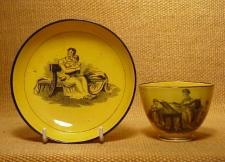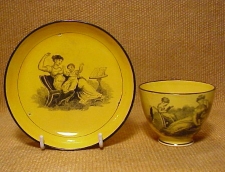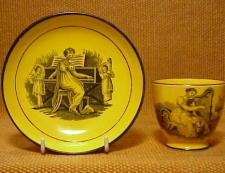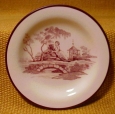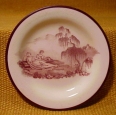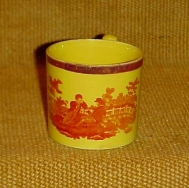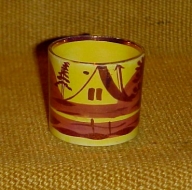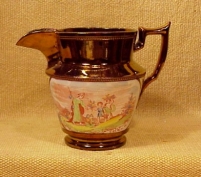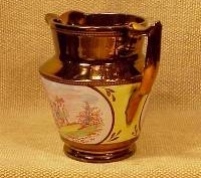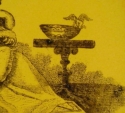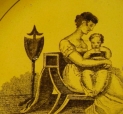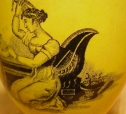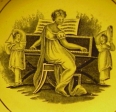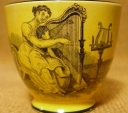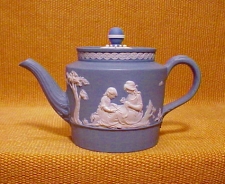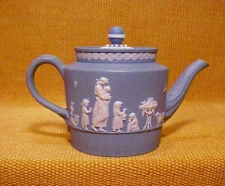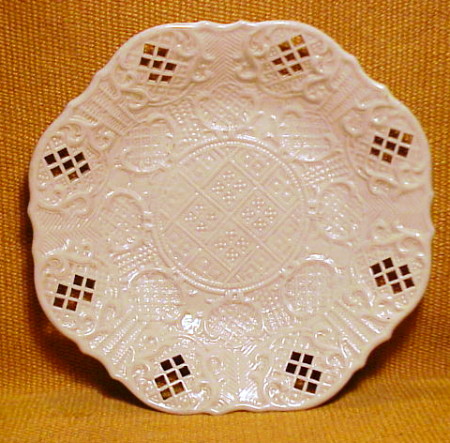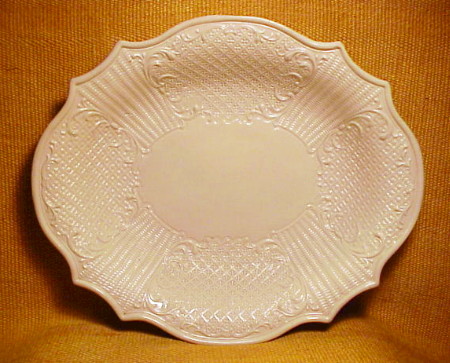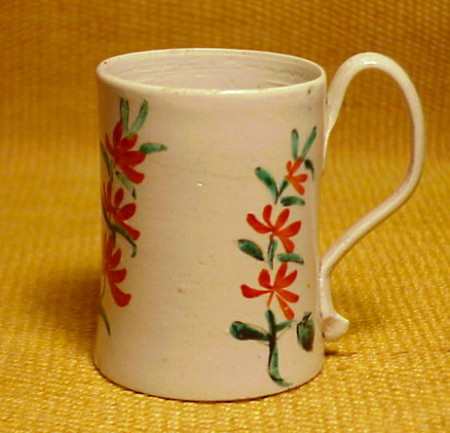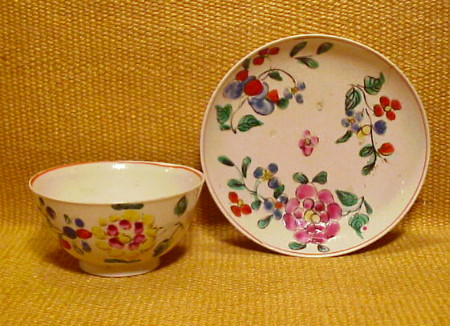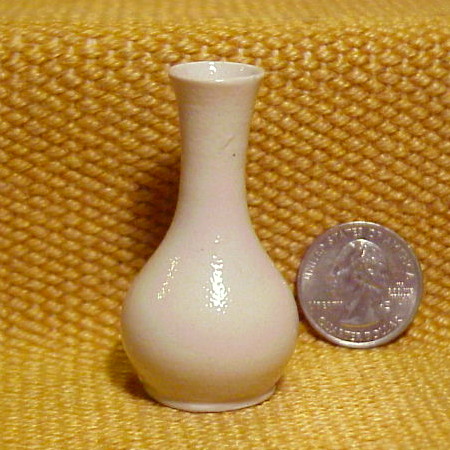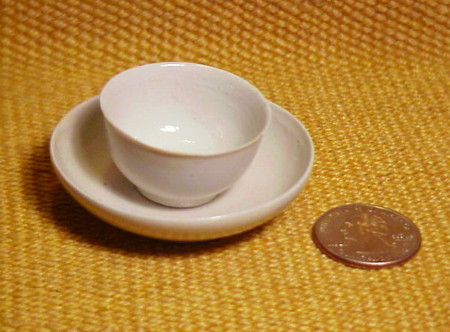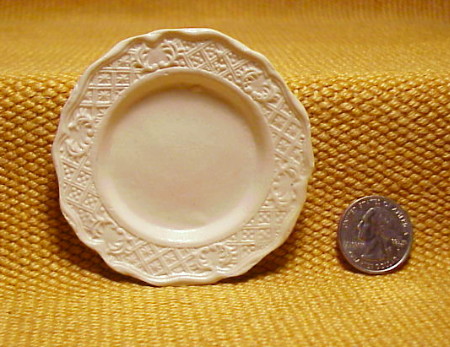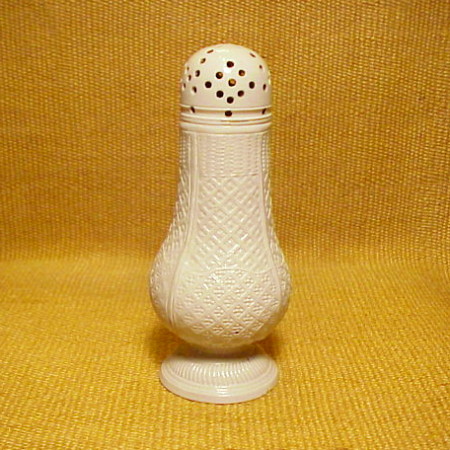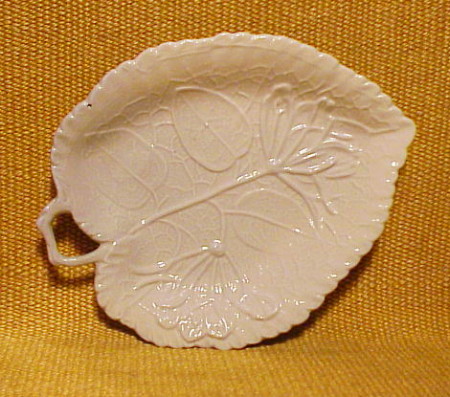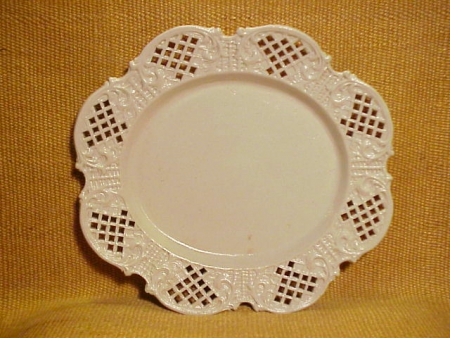Posted By: Mark
Posted on: 2011-11-20 09:41:19
Featured Item:
Yellow Glazed ("Canary") Cups and Saucers
Transfer Printed "Adam Buck" Designs
Perhaps our surprise over the number of people who claim never to have seen this ware is a sign of our advancing age. A generation or so ago, such teawares were not only well-known but popular and fiercely sought out. Now in one of those curious ebb-and-flows we witness in the antiques trade, they almost never show up in dealers' booths or auctions.
Like many popular collectibles, in their heyday these wares accrued a couple of catchy nicknames (a factor that we have observed often increases the desirability of a collectible). Back then collectors could certainly identify "canary" or "canary lustre" or understand what was meant by an "Adam Buck" pattern. In examining these pieces, we will take a look at the meaning and validity of those nicknames.
 Who was Adam Buck?
Who was Adam Buck?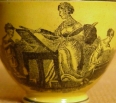 The Adam Buck Patterns
The Adam Buck Patterns

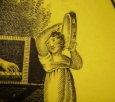 Acknowledgements and Notes
Acknowledgements and NotesPosted By: Mark
Posted on: 2014-03-31 11:06:34
Featured Item: White Salt-Glazed Stoneware
We have added a veritable raft of eighteenth-century white salt-glazed stoneware to the Seekers inventory over the last few months. Clearly it is time for an overview of this unique eighteenth century phenomenon.
Eighteenth century white salt-glazed stoneware is the (significantly more glamorous) Neanderthal man of ceramics. A product of the eighteenth century obsession with porcelain, its development phase – starting in the late seventeenth century -- continued for some fifty years. It achieved immense popularity by mid-century, but such enthusiasm could be sustained for only around twenty years. By the last quarter of the century, public fancy turned to other wares signaling a slow decline in favor which would continue through the end of the century.
Seekers currently offers multiple examples of white salt glaze as shown below. As always, a click on the individual photos will connect the reader to individual listings.
What is Salt-Glazed Stoneware?
All ceramic bodies are characterized by specific combinations of clays and firing temperatures—traits that allow them to be divided into general categories. The first cut divides pottery from porcelain. Pottery can then be broken down into earthenwares and stonewares. (Previous features have discussed the categories of hard paste and soft paste porcelain.)
For additional clarity, we turn to Hillary Young’s, English Porcelain, 1745-1795 and Salt-Glazed Stoneware In Early America by the team of Janine Skerry and Susanne Findlen Hood.
Earthenware, the most basic ceramic body, is a combination of various clays fired at relatively low temperatures, usually in the region of 1000 C. Since the firing is not intense enough to cause the vessels to become watertight, earthenware items require additional glaze.
Stoneware production utilizes a more sophisticated combination of specific clays which when fired at higher temperatures, usually around 1200 C., fuse to create a watertight body. Additional surface glaze is, therefore, optional(1).
Porcelain derives from another sophisticated combination of specific clays which, when fired around 1300 to 1400 C., vitrify, becoming translucent as well as waterproof. Porcelain, nevertheless, is generally found with additional glaze since the unglazed surface is unpleasant to the touch and vulnerable to marks and stains(2).
A “salt-glaze” is achieved by adding common salt to the stoneware kiln. Intense heat causes the salt to break down into chlorine gas, which is allowed to escape, and sodium, which is left to bond with the clay. The result is a distinctive, hard textured surface adhering tightly to the body. This surface is not only durable, but also resistant to sudden temperature change and the potential corrosive effects of stored foods(3).
Development in England
White salt-glazed stoneware is a refinement of the brown salt glaze stoneware originally perfected in Germany in the 1500’s.
A 1672 patent granted John Dwight of Fulham (London area) the exclusive right to produce porcelain and stoneware. We know that by 1680, Dwight was producing stonewares from a light colored body or dipped in a light slip, pointing the way to a product which could compete with white porcelain(4).
Soon, Dwight’s technology had leaked to the Staffordshire potters, who by the 1720’s dominated the market in white stoneware. The addition of ground and calcined (burned) flint to a special clay imported from Devon and Dorset created a stronger body that was white throughout, eliminating the need for a lighter slip coating. This new body could also be finely potted, further advancing Dwight’s goal of stonewares to rival oriental porcelain. Extant examples are even translucent at times. Further development would focus on decoration.
Decoration
Once a refined stoneware body had been achieved, multiple methods of decoration followed. These ranged from sgraffito designs (literally scratched into the clay and often further highlighted with pigments) to a process in which clay was shredded to create a gravel-like surface. The two techniques relevant to us are enameled and molded decoration.
Enameled White Salt-Glazed Stoneware Mug and Tea Bowl & Saucer
Prices: Mug $975.00, Tea Bowl & Saucer $750.00
Simple and straight forward, enameled decoration ranges from the naive floral sprays shown here to more complex scenes reminiscent of French landscape painting. Dating roughly from the 1760’s, enameled decoration was achieved through the hand-application of glass-like mineral compounds to the fired surface. The result was a brilliance previously found only on porcelain; however, such brilliance came at a cost. A second firing was necessary to fuse the decoration to the surface, adding significantly to the expense of producing enamel decorated wares(5).
Press Molded White Salt-Glazed Stoneware Reticulated Plate and Oval Tray
Prices: Reticulated Plate $495.00 , Oval Tray $1350.00
An alternative decorative approach was to incorporate a relief design into the walls of a molded vessel. There are two types of molded production: press molded and slip cast.
In press molding, clay is literally pressed into the mold and allowed to dry creating a separate cast of the mold design. Generally substantial, the end result is also notable for its durability.
In slip casting, the clay, thinned to a liquid “slip,” is poured into the mold. Once the slip has dried, the mold is dis-assembled and separated from the cast. The casting method produces a lighter, thinner-walled vessel. Any relief decoration will generally “telegraph” through, leaving traces in the interior surfaces (and often providing a handy clue to detect slip casting.)
Molded decoration was practiced on a limited scale from the 1830’s -- especially for small components like knobs, handles, or feet and small sprig designs which could be applied to the surface. However, the technology was largely limited by the nature of the molds themselves which were made of wood, alabaster, biscuit fired clay, and occasionally even metal. Production of new molds was both time consuming and expensive.
In 1740, a game-changer appeared with the introduction of plaster of paris. This new substance afforded quick and efficient production of new molds as old ones wore out. In addition, plaster of paris molds were much more efficient in drawing the moisture out of the clay or slip. This added speed and efficiency was reflected in a cleaner finish for the molded components.
Press-Molded White Salt-Glazed Stoneware Sugar Caster and Leaf Shape Pickle Dish
Prices: Sugar Caster $1250.00, Leaf Shape Pickle Dish $595.00
Plaster of paris molds were ideal for the production of flat press molded items such as plates and platters. Furthermore, this new technology expanded the possibilities for holloware production, from delicate slip cast teawares to larger press molded forms like soup tureens, bowls and baskets(6).
White Salt-glazed Stoneware and the Market for Gentility
By 1750, white salt- glazed wares had attained a strong foothold in a changing English marketplace.
In the mid eighteenth century, improvements in agriculture, manufacturing and trade, even colonial expansion created new wealth in Britain, wealth that extended beyond the traditional landed aristocracy. The greatest impact of this new money was on the “middling” classes: manufacturers, merchants and urban professionals. Their new found prosperity was expressed in the consumption of food, entertainment and newly attainable goods. Their increased leisure time was spent in pursuit of culture and refinement.
One of the means for acceptance in this new urban centered society was a knowledge of gentility and politeness – which was understood to be not only a knowledge of good manners and appropriate behavior, but also of sophisticated ornamental display—what today we might call good taste. One consequence of this shift was the growing importance of the social rituals of eating, drinking and entertaining in this new society(7).
Press Molded White Salt-Glazed Basket and Undertray
Price: $3750.00
While this new behavior created opportunity for merchants and manufacturers alike, its scale did not approach the extraordinary excesses of the landed aristocracy. White stonewares provided a more affordable finery with a level of material elegance comparable to aristocratic porcelain and silver. In fact, when one looks at a piece like the basket and undertray shown here or at the compendium of white salt-glazed stoneware plate patterns assembled by Angelika Kuettner of Colonial Williamsburg (8), one cannot help but suspect a silver inspiration.
The potters themselves sensed the potential market which the emerging classes represented, expanding their offerings beyond tea and dining wares to such purely ornamental goods as cornucopia wall pockets and figures, both stately and piquant. Perhaps the greatest markers of luxury status are the toy pieces one occasionally encounters.
White Salt-Glazed Miniatures: Press-Molded Dinner Plate
Wheel Thrown Tea Bowl and Saucer, Water Bottle
Prices: Dinner Plate, $1100.00, Tea Bowl and Saucer $1250.00, Water Bottle $1250.00.
Our tiny dinner plate, tea bowl and saucer, and water bottle (likely once part of a toy chamber set) bear witness to this phenomenon. When one adds the phrase “for the children” to any product -- whether to teach or simply amuse -- the most extreme heights of product variety and indulgence have been attained.
The Decline of Salt-Glazed Stonewares
So what happened to the passion for white salt-glazed wares? Why did they disappear so quickly and so completely?
In a scenario repeated time and again in ceramics (newly-produced or antique), a market which heats up too quickly will burn itself out. Potters, anxious to make the most of the perceived market, produced at a pace that exceeded the actual demand in quantity and variety. In order to survive, wares were offered at lower prices, and accordingly were produced more cheaply; quality spiraled downward. By the century’s end, the white salt-glazed wares had lost their glamour, returning to the lowly utilitarian status that had been occupied by their brown German ancestors.
What better source could there be than Josiah Wedgwood—entrepreneur and catalyst—to comment on the subsequent ceramic phase? Reminiscing on his association with Thomas Whieldon, he recalled:
“White Stone Ware was the principal article of our manufacture. But this had been a long time, and the prices were now reduced so low that the potters could not afford to bestow much expense upon it…, these considerations induced me to try for some more solid improvements, as well in the Body as the Glazes, the Colours and the Forms of the articles of our manufacture.”
The result was creamware, which Wedgwood with his un-erring sense of marketing christened Queen’s Ware after attaining that important first royal commission. And it was this Queensware which supplanted white salt-glazed stoneware by 1780(9).
Later, Mark
Footnotes and Sources
(1) Skerry, Janine E. and Hood, Suzanne Findlen. Salt-Glazed Stoneware In Early America. The Colonial Williamsburg Foundation, Williamsburg, Virginia, 2009. p. 1.
(2) Young, Hillary. English Porcelain, 1745-1795, Its Makers, Design, Marketing and Consumption. V&A Publications, London, 1999. p. 16.
(3) Skerry, Janine E. and Hood, Suzanne Findlen. Op Cit, Salt Glazed Stoneware, p. 1.
(4) Skerry, Janine E. and Hood, Suzanne Findlen. Ibid, Salt Glazed Stoneware, pp. 66,93.
(5) Skerry, Janine E. and Hood, Suzanne Findlen. Ibid, Salt Glazed Stoneware, p. 123.
(6) Skerry, Janine E. and Hood, Suzanne Findlen. Ibid, Salt Glazed Stoneware, pp. 114, 115.
(7) Young, Hillary. English Porcelain, 1745-1795, Op Cit, pp. 10-12.
(8) Skerry, Janine E. and Hood, Suzanne Findlen. Op Cit, Salt Glazed Stoneware, Appendix A: “White Salt-Glazed Stoneware Plate Patterns,” p. 226-239.
(9) Lockett, Terry "Salt-Glazed Stoneware" in Lockett and Halfpenny. Stonewares & Stone Chinas of Northern England to 1851. City Museum and Art Gallery, Stoke-on-Trent, 1982, p. 38.
« Prev
Next »









